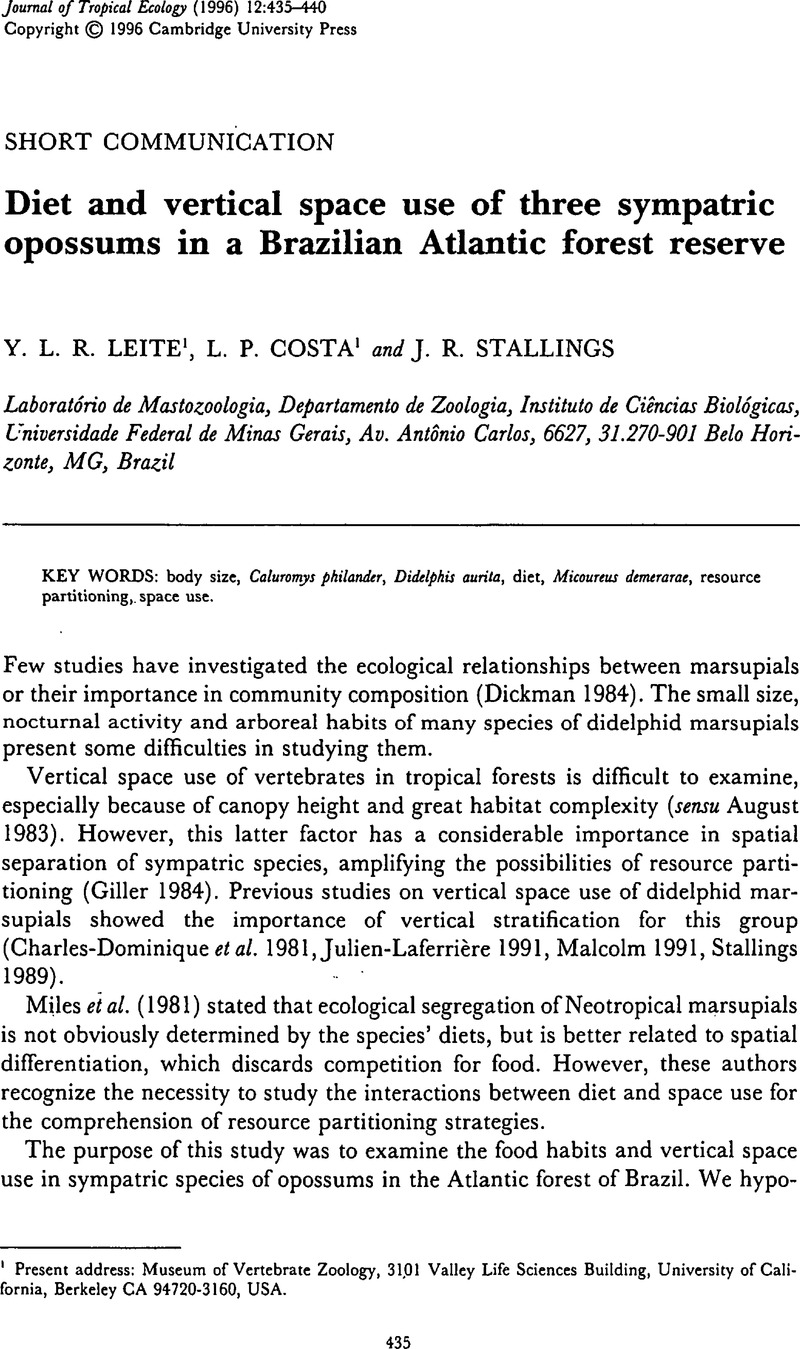Crossref Citations
This article has been cited by the following publications. This list is generated based on data provided by Crossref.
Lemelin, Pierre
1999.
Morphological correlates of substrate use in didelphid marsupials: implications for primate origins.
Journal of Zoology,
Vol. 247,
Issue. 2,
p.
165.
Brammall, J.R.
1999.
A new petauroid possum from the Oligo-Miocene of Riversleigh, northwestern Queensland.
Alcheringa: An Australasian Journal of Palaeontology,
Vol. 23,
Issue. 1,
p.
31.
Barker, Martin G.
and
Pinard, Michelle A.
2001.
Tropical Forest Canopies: Ecology and Management.
Vol. 69,
Issue. ,
p.
23.
Cunha, André A.
and
Vieira, Marcus V.
2002.
Support diameter, incline, and vertical movements of four didelphid marsupials in the Atlantic forest of Brazil.
Journal of Zoology,
Vol. 258,
Issue. 4,
p.
419.
Lemos, Bernardo
and
Cerqueira, Rui
2002.
MORPHOLOGICAL DIFFERENTIATION IN THE WHITE-EARED OPOSSUM GROUP (DIDELPHIDAE: DIDELPHIS).
Journal of Mammalogy,
Vol. 83,
Issue. 2,
p.
354.
Pires, Alexandra S
Koeler Lira, Paula
Fernandez, Fernando A.S
Schittini, Gilberto M
and
Oliveira, Leonardo C
2002.
Frequency of movements of small mammals among Atlantic Coastal Forest fragments in Brazil.
Biological Conservation,
Vol. 108,
Issue. 2,
p.
229.
Cáceres, N.C.
2004.
Diet of three didelphid marsupials (Mammalia, Didelphimorphia) in southern Brazil.
Mammalian Biology,
Vol. 69,
Issue. 6,
p.
430.
Brito, Daniel
Oliveira, Leonardo C.
and
Mello, Marco Aurélio R.
2004.
An overview of mammalian conservation at Poço das Antas Biological Reserve, southeastern Brazil.
Journal for Nature Conservation,
Vol. 12,
Issue. 4,
p.
219.
Lambert, Thomas D.
Malcolm, Jay R.
and
Zimmerman, Barbara L.
2005.
VARIATION IN SMALL MAMMAL SPECIES RICHNESS BY TRAP HEIGHT AND TRAP TYPE IN SOUTHEASTERN AMAZONIA.
Journal of Mammalogy,
Vol. 86,
Issue. 5,
p.
982.
Carvalho, F.M.V.
Fernandez, F.A.S.
and
Nessimian, J.L.
2005.
Food habits of sympatric opossums coexisting in small Atlantic Forest fragments in Brazil.
Mammalian Biology,
Vol. 70,
Issue. 6,
p.
366.
Pires, Alexandra S
Fernandez, Fernando AS
de Freitas, Daniela
and
Feliciano, Barbara R
2005.
Influence of edge and fire-induced changes on spatial distribution of small mammals in Brazilian Atlantic forest fragments.
Studies on Neotropical Fauna and Environment,
Vol. 40,
Issue. 1,
p.
7.
Cunha, André A.
and
Vieira, Marcus V.
2005.
Age, season, and arboreal movements of the opossumDidelphis aurita in an Atlantic rain forest of Brazil.
Acta Theriologica,
Vol. 50,
Issue. 4,
p.
551.
Fernandes, Marcus E. B.
Andrade, Fernanda A. G.
and
Silva Júnior, José de S. e
2006.
Dieta de Micoureus demerarae (Thomas) (Mammalia, Didelphidae) associada às florestas contíguas de mangue e terra firme em Bragança, Pará, Brasil.
Revista Brasileira de Zoologia,
Vol. 23,
Issue. 4,
p.
1087.
Rader, R.
and
Krockenberger, A.
2006.
Does resource availability govern vertical stratification of small mammals in an Australian lowland tropical rainforest?.
Wildlife Research,
Vol. 33,
Issue. 7,
p.
571.
Pardini, Renata
and
Umetsu, Fabiana
2006.
Pequenos mamíferos não-voadores da Reserva Florestal do Morro Grande: distribuição das espécies e da diversidade em uma área de Mata Atlântica.
Biota Neotropica,
Vol. 6,
Issue. 2,
Ribeiro, Marcel Cintra Pereira
and
Bicudo, José Eduardo Pereira Wilken
2007.
Oxygen consumption and thermoregulatory responses in three species of South American marsupials.
Comparative Biochemistry and Physiology Part A: Molecular & Integrative Physiology,
Vol. 147,
Issue. 3,
p.
658.
Leiner, Natalia O.
and
Silva, Wesley R.
2007.
Seasonal Variation in the Diet of the Brazilian Slender Opossum (Marmosops paulensis) in a Montane Atlantic Forest Area, Southeastern Brazil.
Journal of Mammalogy,
Vol. 88,
Issue. 1,
p.
158.
Crosby, Kirsten
2007.
Rediagnosis of the fossil species assigned toStrigocuscus(Marsupialia, Phalangeridae), with description of a new genus and three new species.
Alcheringa: An Australasian Journal of Palaeontology,
Vol. 31,
Issue. 1,
p.
33.
Youlatos, Dionisios
2008.
Hallucal grasping behavior in Caluromys (Didelphimorphia: Didelphidae): Implications for primate pedal grasping.
Journal of Human Evolution,
Vol. 55,
Issue. 6,
p.
1096.
Oliveira-Santos, Luiz Gustavo R.
Tortato, Marcos A.
and
Graipel, Maurício E.
2008.
Activity pattern of Atlantic Forest small arboreal mammals as revealed by camera traps.
Journal of Tropical Ecology,
Vol. 24,
Issue. 05,
p.
563.





